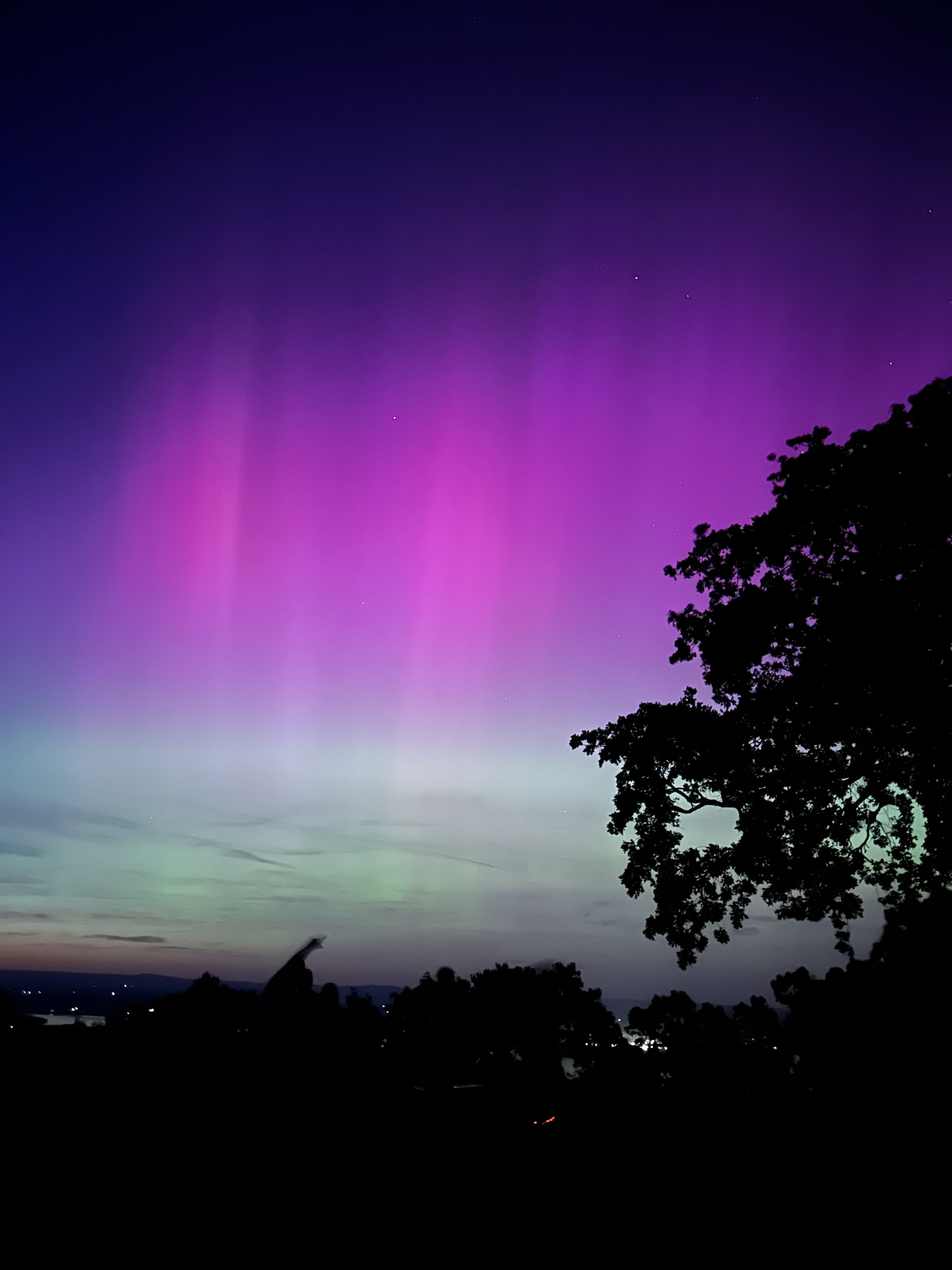Aurora Borealis, aka Northern Lights of May 10
Contact
University of Arkansas System Division of Agriculture
Cooperative Extension Service
2301 S. University Ave.
Little Rock, AR 72204

Aurora Borealis, aka Northern Lights of May 10
I saw a whiff of pink above the treetops on May 10, but my son Jeff was able to get a good view of this magnificent celestial event from atop Mt. Nebo near Russellville. I still remember seeing them as a child, probably in 1958, when solar storms caused the southward creep of the Aurora Borealis into central Oklahoma. The 2024 event was even stronger, with the display being seen throughout Arkansas, well into Florida and southern California.

THE ICY SKIES AT NIGHT — My son Jeff Klingaman captured this photo at 9:00 pm of the May 10th Northern Lights display from atop Mount Nebo, looking north towards the lights of Russellville. (Image courtesy Gerald Klingaman.)
The Northern Lights, and its southern hemisphere counterpart, Aurora Australis, are not especially rare, but mostly they are confined to within 10 to 20 degrees of the north or south poles. For them to extend this far south is unusual. They are associated with storms on the surface of the sun and are correlated with increased sunspot activity that occurs about once every eleven years.
The solar winds (plasma) are composed of free electrons and positively charged particles that stream from the sun and usually take a couple of days to reach Earth. But when a storm blows up, solar winds blow stronger. During the 1859 solar storm dubbed the “Carrington Event,” the storm front reached Earth in less than 18 hours. Interestingly, on Friday morning May 10, the National Oceanic and Atmospheric Administration released from its Space Weather Prediction Center (SWPC) a “Geomagnetic Storm Warning” advising that the storm was coming and electronic communications could be disrupted. The May 10 solar storm was not as big as the Carrington Event, but this was still a big deal.
This storm occurred, say the people at SWPC, when the sun released up to seven coronal mass ejections. This extra energy was dispersed into the normally placid solar winds, and our planet was flooded with billions of tons of solar plasma, causing the upper atmosphere to swell like a sprained ankle. Normally, most of the electrons in the solar winds are shunted around the Earth, trapped in the planet’s magnetosphere. But with a big storm event, the “pitch angle” of the incoming electrons decreases, and more make their way into the upper atmosphere.
These electrons provide the energy, as they collide with oxygen and nitrogen, that change the valence state of the elements which in turn release photons due to their increased excitation. The color we see depends on how high in the atmosphere these collisions occur and the proportion of green and red light that is being mixed. Green is the most common color, pink the second most common with blue the least. The storm started just after noon, but could only be seen with the naked eye once it got dark.
The strength of the Earth’s magnetic field is measured in nanoteslas (nT). Normally we experience a baseline reading of -20 nT, but this storm jumped the reading to -412 nTs. This is big, but compared to the estimated -1750 nT of the 1859 storm, it was fairly modest. In 1859, the electronics of the day consisted of battery-powered telegraph lines. Operators found that they could only operate their systems by disconnecting the batteries and using the power generated by the solar storm to send and receive messages. If a storm equivalent to the Covington Event (so named because an armature astronomer observed massive solar flares just before the solar storm and the almost worldwide display of the Aurora) were to occur today it is anticipated there would be widespread failure of Earth and satellite bound communications and almost all GPS navigation.
Some reports of troubles with communication were reported, including my cell phone seeming to stop working for a few hours. Farmers in South Dakota, Nebraska, Indiana and Kansas experienced disruption of their GPS systems which allow the use of precision planters. The swelling of the upper atmosphere causes increased drag on low-Earth orbit satellites. In 2022 SpaceX lost 38 StarLink satellites due to a minor storm that caused unexpected atmospheric swelling. The Hubble Space Telescope experienced increased drag, and because of this will probably return to Earth a few days ahead of its mid-2030s return. But overall, we seem to have dodged the bullet, with no lasting damage.
The Aurora of last week was a beautiful and memorable event for those lucky enough to see it in person. But it is a reminder that we live in a complicated world, and as songwriter Effron White says in his song “Built by Man,” all of this stuff can fail.